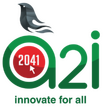Service Process Simplification
Equipping civil servants with a tool to simplify access to public services thereby reducing the time, cost and number of visits (TCV) required for citizens to access them.
A Smart Health Care System through A Smart Health Card

Problems:
The risk of different diseases increases with age including amnesia and different other complications. Thus, they need proper treatment at this age but in maximum cases, due to memory loss, they can’t provide the previous history of different diseases accurately. Moreover, the absence of a health card makes doctors unable to identify the diseases correctly without disease investigation. Therefore, they prescribe different diagnostic tests which lead elder persons to spend a large amount of money, time and several times visiting. Thus, the total time, cost and visit for regular health checkups seemed to be a pressure to a senior citizen who does not have that much physical and financial ability.
Solution:
At first, a database of senior citizens aged over 60 years has been developed. In this database information such as their name, age, blood group, disease history, family history on different diseases, fingerprint, the picture is kept. Then a senior person is provided a smart ID Card with respect to the ID of the database. To ensure their good health condition, regular follow-up and checkup facilities have been provided through the smart ID card every two months. In fact, every two months doctors’ next appointment and checkup time with a well-wishing message has been provided to the patients to remind and call them at the hospital on their cell phone. In addition, database software has also been developed based on the information of that database.
To make this initiative sustainable, that database software has been attached to a server connected with different doctors of the Pourashava. A doctor has been able to know all previous disease histories of the patients by punching this ID card in a card reader machine which helps him to identify the disease correctly. As well as in this system a computerized prescription is given to the patients which are automatically saved on patients’ ID with the aim to give guidelines to any other doctor for future cases. Moreover, in the case of a missing card or any problem with the card, a doctor can also see all the information of the patients through their fingerprint.
Result:
For the first visit, a person has to come physically, he has to spend almost 2000 taka including traveling cost, doctors’ fee and diagnostic test fee. And for follow-up, he has to spend 800 Taka including doctor fee and travel costs for every visit. After completing the pilot project, now he has to spend 1 hour and 500 Taka for medical examination, 25 Taka as visit cost in total 525 Taka for the first visit. For the second visit, he has to spend only one hour (Particularly) and 25 Taka as per the doctor’s visit.
So, the result shows a significant reduction in TCV by 95%, 75% and 55% respectively.
Besides, one of the greatest achievements of this particular project is able to ensure a good health service and the senior citizens of that area are no more deprived of their required health service.
A citizen’s perspective on the need for simplifying access to public services
Mintu, who retired at 59 after teaching for over 30 years in public primary schools, had to submit 21 different types of documents as part of his pension application. They included his nationality certificate, birth certificate, and even his letter of appointment.
So, he had to spend a total of 28 working days, incur high transportation and even accommodation costs (since he had to travel and stay overnight outside his home district) and visit various government offices multiple times just to get himself in a position to apply.
Service Process Simplification (SPS): a2i’s innovative tool for reducing citizens’ hassle
‘Business Process Re-engineering’ (BPR) is a popular methodology in the private sector for optimizing end-to-end processes and automating non-value-added tasks to boost productivity. a2i took the BPR concept and essentially rebranded it ‘Service Process Simplification’ (SPS) since it was more meaningful to policymakers and government service providers who did not consider themselves to be engaged in either ‘business’ or ‘engineering’!
In collaboration with the Cabinet Division and government ministries (which formulate policies) and their directorates (which are responsible for service delivery).
a2i trained civil servants to apply SPS by mapping out entire service delivery processes end-to-end, eliminating unnecessary steps and redesigning them to be more easily accessible to citizens from a greater number of delivery points. Detailed profiles were also developed containing descriptions, process maps, relevant fees and documents needed to access the new, simplified services as well as grievance redressal processes, and associated rules, policies and laws. These profiles were published both in hard copy (in the form of books) and online at Bangladesh Services Portal. This not only represents extraordinary service delivery reform but also unprecedented proactive disclosure on the part of the government.
Impact & Results
If Mintu were to apply for his pension now, he would only need to submit 8 documents and spend 8 working days – a considerable improvement on the original 21 documents and 28 working days.
To date, a2i has trained over 935 officers from 36 government organizations to apply SPS to 400+ vital services. Moreover, each Annual Performance Agreement signed between the Cabinet Secretary and the Secretary of a particular ministry now mandates simplification of at least one service and digitization of a service every year – an important step towards institutionalizing this citizen-centric way of improving public services.
To read other publications click here


